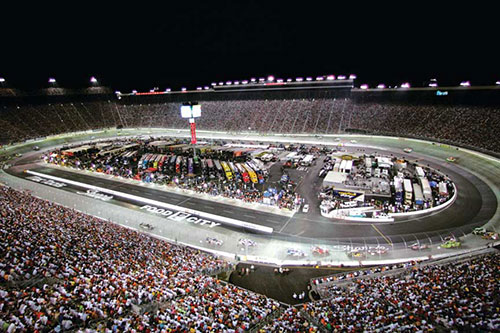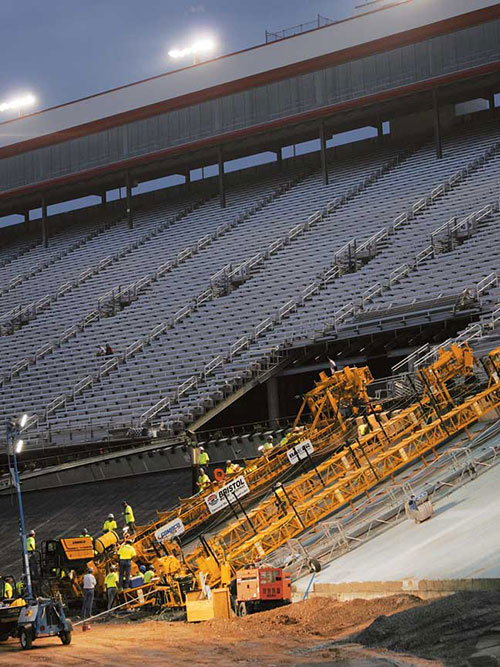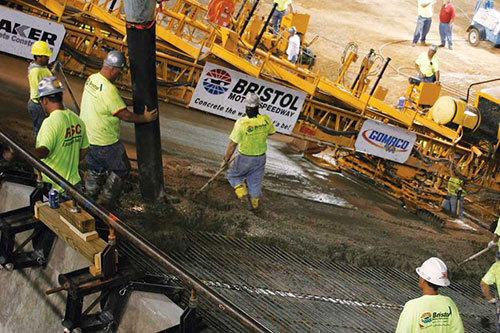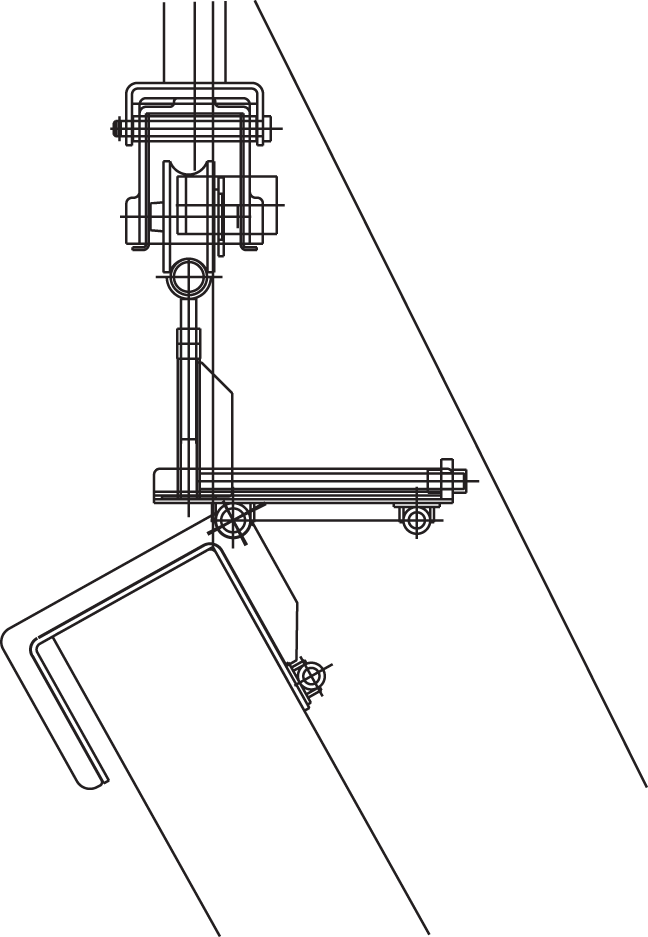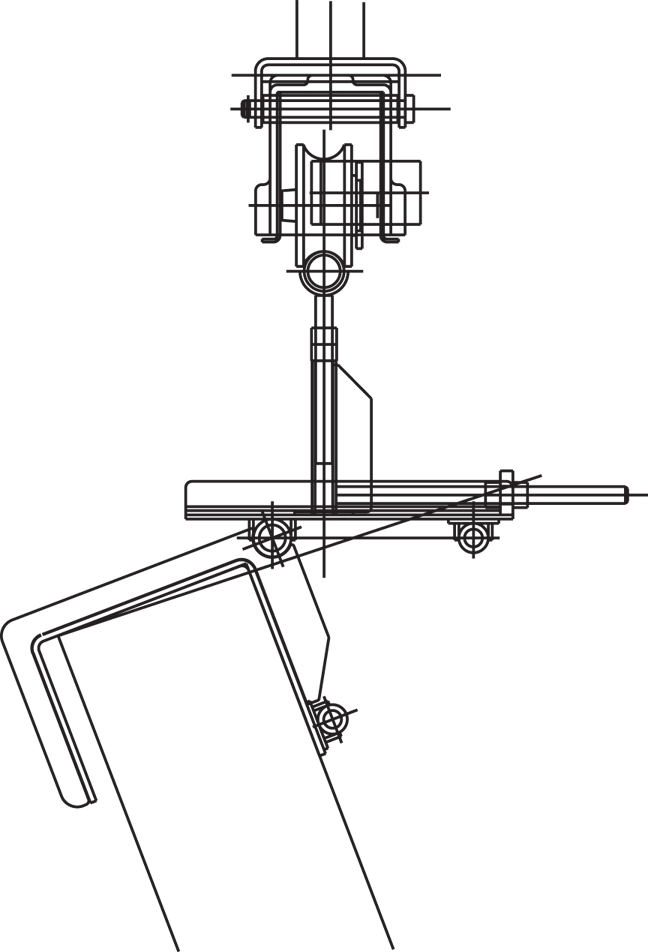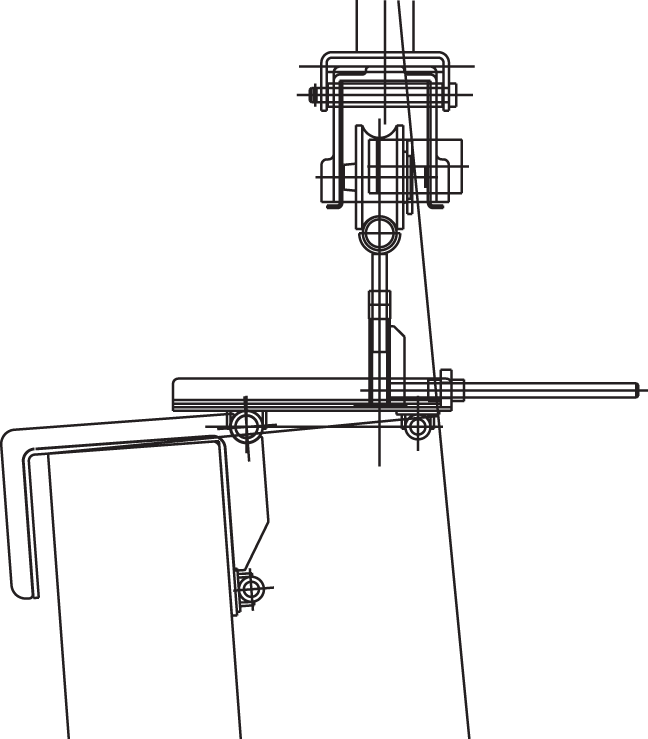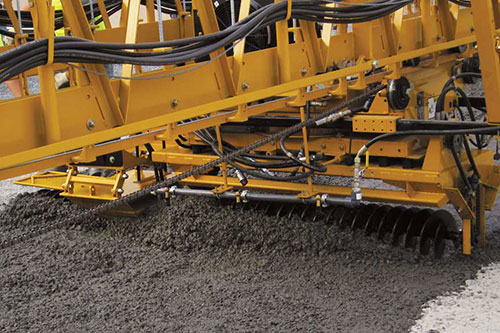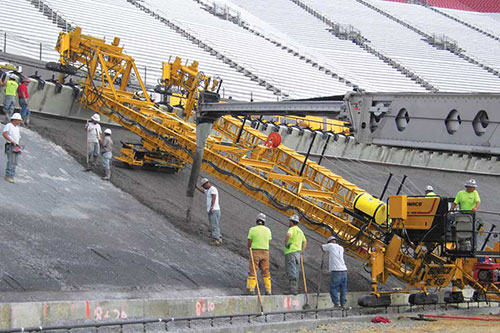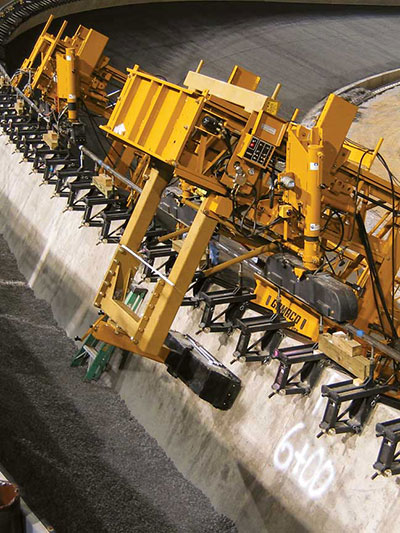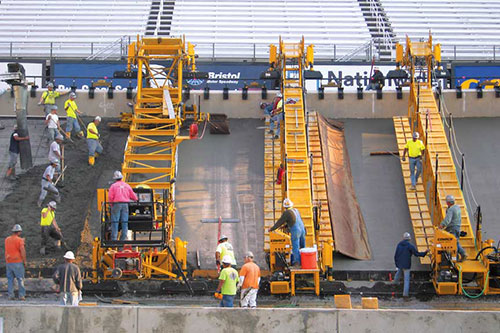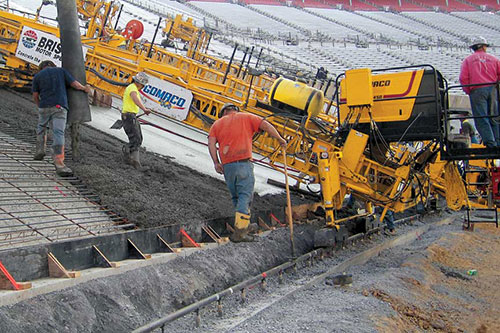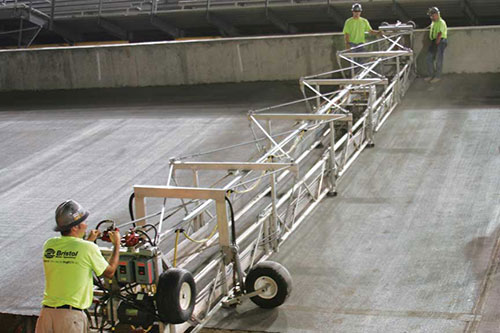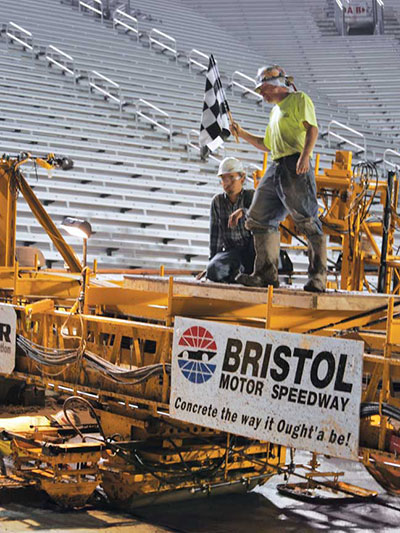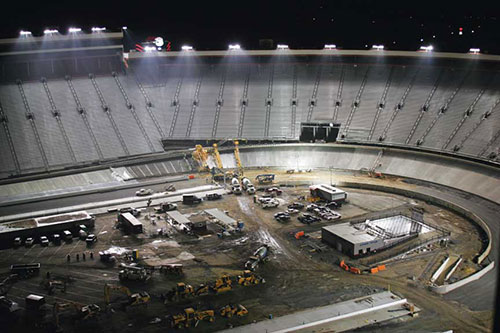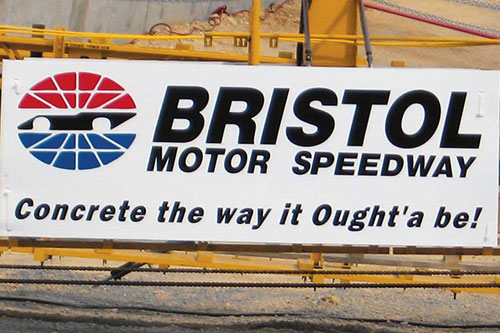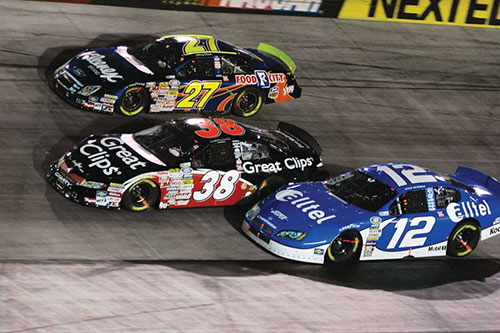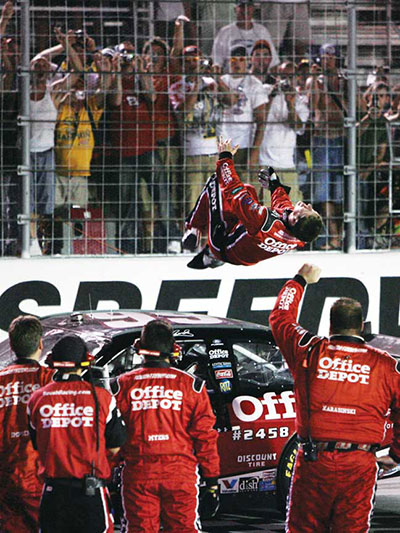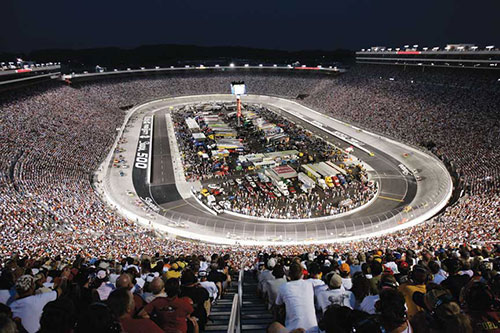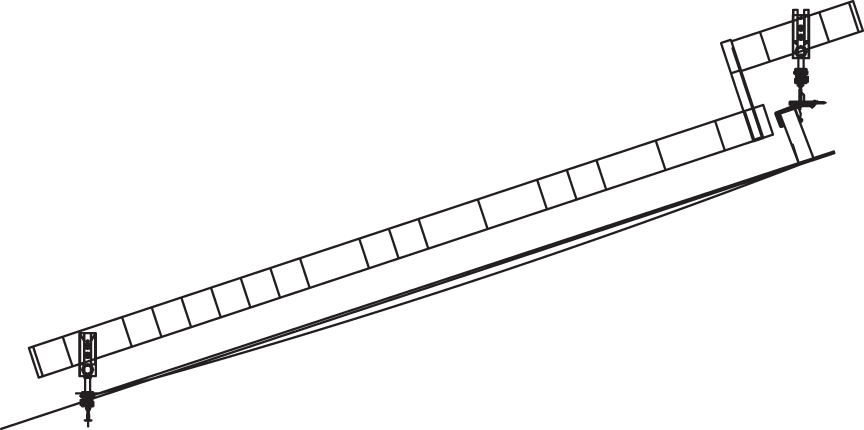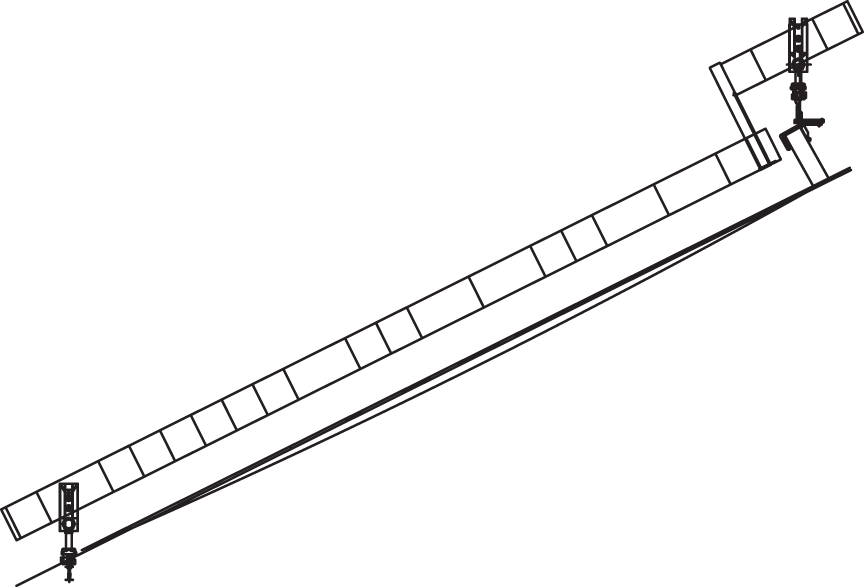GOMACO World Index --- GOMACO World 36.1 - January 2008
Smooth Driving at the World’s Fastest Half-Mile ...an Engineering and Construction Feat!
“Edwards Claims Sharpie 500” stated a news release from the Bristol Motor Speedway. It went on to detail how Carl Edwards, in his #99 car, earned his first win ever at the Speedway during the Saturday night race on August 27. He took the lead on lap 371 and led the rest of the race.
“This is the biggest win of my career,” said Edwards, who performed his usual celebratory backflip in front of the crowd of nearly 160,000 fans. “I think in the big picture this is a transition race. You’ve gone from an older style car at the track that’s been the way it’s been for however many years to a new style race track. It looks a lot the same, but sure isn’t the same...”
The .533 mile (0.86 km) track at Bristol is definitely not the same track it was earlier this year. Speedway Motorsports Inc., owners of the track, made the decision to completely remove and replace the track and surrounding structures between the spring and fall races. All of the work would have to be completed in a 13 week time frame. Missing the deadline was simply unthinkable
The Sharpie 500, the first race on the new surface, was already sold out. Approximately 160,000 fans had their tickets already in hand for the race, and going to Bristol is the ultimate experience for a NASCAR fan. Bristol is annually voted the #1 track by NASCAR fans and the Sharpie 500 is one of the Top 10 Hottest Tickets in all of American sports. According to ESPN.com, it rivals such sporting events as golf’s Masters, baseball’s World Series, and football’s Super Bowl.
But Bristol’s track was failing. Its asphalt track was replaced in 1992 with post-tensioned concrete. Over the years, several design flaws with the post-tensioning and drainage system revealed themselves.
“It was just falling apart,” Steve Swift, Construction Manager for Speedway Motorsports, explained. “We had numerous places where the track had failed through the years that we had patched. You can look at old pictures and see all of the patches. It was a constant battle just to repair. We debated whether to keep it concrete or go back to asphalt, and wanting something that would last the longest, we decided to go back with concrete.”
They contacted Baker Concrete Construction Inc., based out of Monroe, Ohio, to help them build their new track and other structures at the Speedway.
Baker would be responsible for building 2900 feet (884 m) of perimeter crash wall, 3380 feet (1030 m) of interior crash wall, 4000 square yards (3344 m2) of seven inch (178 mm) apron paving, 13,000 square yards (10,869 m2) of four to six inch (102 to 152 mm) lean concrete base, and 13,000 square yards (10,869 m2) of seven inch (178 mm) continuously reinforced concrete pavement.
Demolition of the old track began the day after the spring race, the Food City 500, on March 26.
“We mobilized on April 9 and were given 13 weeks to complete our portion of the project,” Jim Hosea, Project Manager for Baker Concrete, said. “Our work involved the total reconstruction of the track, the perimeter crash walls, interior crash walls, pit row pavements, and pit row walls.”
Long before Baker ever mobilized at the track, they were working with Speedway Motorsports and outside engineering firms designing Bristol’s new track. Racing at Bristol, for a number of years, had been limited to single file. If a driver wanted to pass, they had to bump the car ahead of them out of the way. The owners wanted to see that changed.
“We talked to a lot of the drivers and got input from them, what they would like to see, and we took all that information to our engineers,” Swift explained. “The old track’s transitions were very short where they come out of the turns and come into the straight-away. There’s a transition there that rolls the car over from being in the high bank to a relatively flat bank. It actually had a crown in the old track. That’s why they ran one groove at Bristol for so long, because in the second groove the track rolled over and it would push them into the wall.
“This new track has just the opposite. It’s a parabolic shape so the higher they go, the faster they can go and keep up with the bottom car. The upper car can keep up with the lower car and overcome distance with speed.”
The design looked good on paper, but it had its paving challenges. First off, they would be paving on slopes up to 30 degrees. The track’s parabolic shape added another degree of difficulty. Smoothness of the final product was also another major concern. Baker Concrete chose GOMACO to manufacture their equipment and turned to the company’s engineering department for some additional design help.
“Early on we selected GOMACO to furnish the paving equipment,” Hosea said. “The engineering was tricky on the job and it required an awful lot of input from the machine manufacturer, as well as the track designer.”
Baker’s crew poured under the lights at Bristol Motor Speedway. Just 13 weeks later, the new track was premiered in a series of NASCAR racing events.
“Actually, the engineering department at GOMACO is one of the reasons we chose them for the job,” Rob Ford, Project Coordinator for Baker Concrete, added. “They have a very strong engineering department and we knew they could handle it.”
GOMACO’s answer was an SL-450 slope finisher with some added features. Two work bridges would follow behind the finisher for handwork, brooming and curing. All of the equipment would run on a rail system and the top section of rail was mounted to the new crash wall using specially designed brackets.
“GOMACO designed a special bracket that was able to accept 18 inches (457 mm) of horizontal movement and 14 inches (356 mm) of vertical movement to handle how the paver adjusted as it went around the track,” Ford explained. “The key was to keep the end of the C-450’s frame close to the wall to minimize the amount of hand finishing. There was a lot of intensive engineering involved in that process to get the machine in the right place everywhere on the track.”
At the bottom of the track, a footing was poured to mount the rail brackets on. The footing varied in its location relative to the track, both in height and horizontal distance. Each one of the rail cradle heads had to be shot in by a surveyor using a total station to guarantee their correct placement, and ultimately the correct grade on the track through all of the transitions.
“There was major surveying involved because of the slope changes,” Dennis Ernst, Service Manager for GOMACO, explained. “The rail height would change as the slope changed. All of those grade changes were shot into the rail by the surveyor. As the track widened through the transition, the rails would widen and adjust horizontally so we could keep a constant grade.”
The key to accomplishing those changes easily were fully automated legs with slope sensors on the SL-450. The legs would automatically adjust to plumb, or a true vertical position, as the rails changed widths through the transitions. No manual adjustments were necessary.
“We had fully automated legs so as you came out of the lower slope sections and you went into what they call full super, the legs automatically adjusted vertically,” Ford said. “We didn’t want to have to be doing that by hand.”
Before each pour, the SL-450 was dry run to make sure the machine was hitting grade. The surveyor was on hand to shoot various points across the length of the pour to ensure an accurate final product.
The track was paved on top of a massive subbase. One of Bristol’s old issues was substantial water and drainage problems. Bristol’s new subgrade started with the removal of 3.5 to four feet (1.1 to 1.2 m) of dirt all the way around the track. A geotech matting was laid on top of freshly cut dirt. Two feet (0.6 m) of four to five inch (102 to 127 mm) stone was placed on top of the matting. A six inch (152 mm) lift of 0.5 to 0.75 inch (13 to 19 mm) stone was placed on top of the larger rock. Three feet (0.9 m) of a ground shell material was then added for fill. The top layer was six inches (152 mm) of crushed stone with a 13 percent lime content.
The next step for the track was a new four inch (102 mm) thick lean concrete base. Baker’s crew finished the lean base with their SL-450. The roller on the SL-450 was replaced with an auger to give the lean base a rougher finish. The rough surface would help create a better bonding surface when the concrete was poured on top of it. The machine was also equipped with a seven inch (178 mm) lowering kit on the drum.
“If we had lowered the entire SL-450 down seven inches (178 mm), it would have shifted it sideways and that was not acceptable,” Ernst said. “The two parabolics in each of the lifts, the lean base and the concrete track, would not have matched then. To overcome this, we used a seven inch (178 mm) lowering kit and set everything to to the top surface of the lean base.”
A huge amount of steel reinforcing was placed on the new lean base to help form the final layer of the track, the continuously reinforced concrete (CRC). Longitudinal steel bars were placed 4.5 inches (114 mm) apart at the top third of the track, five inches (127 mm) in the center third and 5.5 inches (140 mm) in the bottom third. Perpendicular bars were every 30 inches (762 mm). A total of 188 tons of reinforcing steel went into Bristol’s new track.
The SL-450’s legs were fully automated. Slope sensors mounted on all four legs would tell them when to adjust, both horizontally and vertically, to automatically accommodate the many transitions and grade changes in Bristol’s track. A stabilizer, mounted to the top of the SL-450, ran along the side of the wall and helped hold the machine on line through transitions.
The concrete was a standard mix design with a 4000 psi (276 MPa) strength. Slump averaged 1.75 to 2.5 inches (44 to 64 mm). Both the lean base (1200 psi (83 MPa)) and concrete were mixed at a mobile batch plant set up just outside the entrance to Bristol Motor Speedway. Both mixes were placed with a telebelt placer because of the stiff slump of the mix designs.
Paving production on the CRC averaged 45 to 60 feet (13.7 to 18.3 m) per hour. The automatic advance feature on the SL-450 was set to advance eight inches (203 mm) on each pass.
“On the supers and the transitions into the supers, production was a little less because we were going from a 15 percent to a 50 percent or 25 percent to a 50 percent,” Hosea said. “Once we got into the straight-aways, production would increase for us.”
“Getting those transitions right was the key to this whole project,” Ford continued. “There was a lot of complex geometry that was going on during this entire process.”
Two work bridges followed behind the SL-450. The finishers worked from the first work bridge performing handwork operations and surface corrections. Finishers worked from the second bridge applying a light broom texture and spray cure.
Joints were saw cut into the track’s front stretch and back stretch in the transverse direction every five feet (1.5 m). In the slopes, the transverse joint was every ten feet (3 m) on center. Two joints were cut longitudinally, one was 14.5 feet (4.4 m) from the top wall and the second was 14.5 feet (4.4 m) below the first one. Saw cutting the joints on the steep slopes proved an interesting challenge.
“We had to develop a saw that was capable of working on a 57 percent incline,” Hosea said. “Most conventional saws, if they’re gas powered, will run out of oil or run out of gas at that slope. We modified a Soff-Cut G2000 saw with a three-phase electric motor and built a frame that housed it, ran it off the wall, and accomplished all of our sawing on the superelevations with the saw rig.”
Developing a smoothness specification for the new track surface was difficult. The track’s new parabolic shape and the steep slope of the banks made profiling with a standard device almost impossible. Plus, just deciding on what the specification should be was hard to determine. Finally, the measure of acceptable smoothness was left up to the drivers and if they liked racing on the new track.
After 13 intense weeks of demolition and rebuilding, Bristol Motor Speedway was ready to unveil its new track. NASCAR legend and nine-time winner at the World’s Fastest Half-Mile, Rusty Wallace, stopped by the track near the end of July to take a test drive. His verdict?
“On a scale of 1 to 10, what do I think?” Wallace said. “It’s a 10. This place is great. I love the transition. The straight-aways are so smooth.
“It looks fantastic. I didn’t really know what to expect before I got here. I was a little worried about how this was going to turn out, but I tell you, these guys did an unbelievable job. I’ve been through a lot of these (resurfacings) at different places. This ranks right up there at the top. I don’t know how these (Nextel Cup) guys can’t love this. It’s so, so much better. Man, it’s really good.”
The week of August 20 would bring all of the NASCAR events to Bristol, the Craftsman Truck Series, the Busch Series and the Nextel Cup. As each race went by, the drivers had nothing but rave reviews for the new track.
“All I can say is the feedback we got from the drivers... they were all pumped up,” Hosea said. “It was a new Bristol for them. They didn’t have to bump people out of the way. They could run around them on the low groove, the medium groove or the high groove to pass traffic, as needed. They were all enthusiastic that we had given them something that is truly special.”
“The drivers were very, very appreciative of the track and the way that it drove,” Swift said. “Baker Concrete and GOMACO have given us an excellent track and we are more than happy with their product. All the teams that we had, they were the best of the best. We were lucky to have the best contractors and the best suppliers. We honestly feel that way, because if we would have had somebody else, it wouldn’t have worked.”
It was an outstanding job of planning and partnership to complete a challenging project in a short amount of time.
“Our guys put a lot of effort in and worked some long hours,” Ford said. “Everybody had a goal and they were pushing for it. We would pave sometimes 18 hours straight and the guys would still be charging hard, trying to meet all their goals, not slowing down and not giving up.”
“Our working relationship was outstanding with GOMACO,” Hosea said. “It was a wonderful working relationship and things went very, very smooth.”
Editor’s Note: Congratulations to Baker Concrete and Speedway Motor Sports! They were recently awarded the prestigious Harold J. Halm Presidential Award from the American Concrete Pavement Association. The award is in recognition of their outstanding concrete work at Bristol Motor Speedway. Thank you to Bristol Motor Speedway for supplying the driver’s quotes in their news releases and for sharing the photos of race day, seen on the right.
These diagrams illustrate the SL-450’s movement through the changing cross slopes
Subscribe to Receive GOMACO World Magazine

